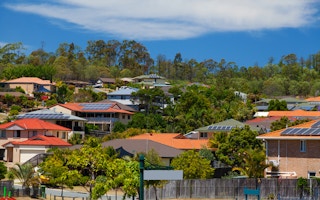Storage technology is the Holy Grail of a clean energy system, and if Australia wants to become 100 per cent renewable-powered, its public and private sectors must drive mass adoption of battery solutions, said industry experts in Sydney last week.
To continue reading, subscribe to Eco‑Business.
There's something for everyone. We offer a range of subscription plans.
- Access our stories and receive our Insights Weekly newsletter with the free EB Member plan.
- Unlock unlimited access to our content and archive with EB Circle.
- Publish your content with EB Premium.
Speaking at the third annual Australian Energy Storage Conference and Exhibition, renewable energy advocate Amy Kean from the New South Wales (NSW) Department of Industry noted that energy storage “unlocks the full potential of renewable sources” by helping to manage the variability of wind and solar power.
“Storage is the pathway to a truly smart and clean energy future,” Kean told the 200-strong audience at the Australian Technology Park. Industry observers also noted that residential and commercial battery storage will increase the uptake of rooftop solar power and reduce demand for energy from the grid.
However, the high cost of batteries today and a lack of detailed information on the technology mean that the uptake of energy storage systems in Australia remains relatively low today, especially in homes.
In Australia’s remote, off-grid regions, battery and solar systems have increasingly been used to replace expensive diesel systems. The price of electricity from these diesel generators can be as expensive as A$450 per megawatt hour, making clean energy technology a sound investment.
However Australia’s Clean Energy Council (CEC) in a 2015 report noted that at an average cost of about A$10,000 per unit, many home owners consider battery storage too expensive. These sytems have a payback period of between six and 12 years, and use lead acid or lithium ion batteries to store excess solar energy.
Although about 15 per cent of households in Australia - that is, about 9.1 million households as of end 2015 - have solar panels on their roofs, only about 500 homes across the country have storage systems installed, the CEC says.
Most observers expect battery prices and payback periods to drop by between 40 and 60 per cent over the next few years due to lower manufacturing costs, increased supply and greater competition, and this should lead to a corresponding increase in demand.
Last year, investment bank Morgan Stanley predicted that more than 1 million Australian homes would install batteries to capture the energy from their storage over the next five years.
The clear benefits of storage technology means that “we don’t need to talk about if it will be deployed”, said Kean. “It’s just about how it will take off.”
To make it easier for residents to understand battery systems, the NSW state government has produced consumer guides and an online tool which lets users calculate costs and payback periods. It will also be conducting state-wide training for customers with commercial premises, she added.
Meanwhile, at the Renewable Cities Forum - an event co-located with the Energy Storage Conference - James Robinson, head of the NSW Office of Environment and Heritage’s business strategy area of energy efficiency, noted that the imminent end of NSW’s Solar Bonus Scheme will also drive more users to adopt batteries to store their excess energy.
The Solar Bonus Scheme is a feed-in-tarrif policy which offers solar system owners payment for energy they channel into the grid. It is set to end this December.
“This, along with Australia’s abundant sunshine is one of many reasons why battery companies are using the country as a test-bed for their products,” Robinson added.
Among the companies which have conducted battery tests in the country are Japanese multinational Panasonic and Western Australian energy provider Synergy, which in November announced the country’s first trial of large-scale battery storage for households with solar panels in Perth’s Alkimos Beach suburb.
Speaking at the same event, Sven Teske, principal researcher at the University of Technology Sydney’s Institute for Sustainable Futures (ISF), noted that storage technologies would be crucial to helping Australia become a nation fully powered by renewable energy.
While this is not a target the country has officially announced, ISF in April found that it is possible for Australia to be fully renewable by 2030, and community groups such as Solar Citizens have also called for the country’s leaders to pursue this goal. Today, renewable energy makes up 14.6 per cent of Australia’s energy mix.
However, many communities around the country have set their own 100 per cent renewable targets.
Among these are Uralla in NSW, which has a population of about 2,000 and is rolling out a solar and energy efficiency blueprint funded by the NSW Office of Environment and Heritage and Byron Shire in northern NSW. The latter is supporting community-owned renewable energy projects to realise its goal to have zero net greenhouse gas emissions by 2025, and eventually be powered only by clean energy.
ISF’s Teske noted that communities should persevere with efforts to scale up renewable energy - which often originates in opposition to coal or nuclear plants - as the momentum will eventually reach the state and federal level.
“The goal of being 100 per cent renewable powered may not be reachable in the immediate future, but it is important to hold that up as a target and keep striving towards it,” he noted. “Otherwise, progress will stagnate”.










